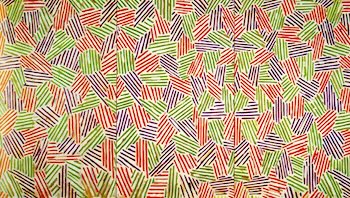Scent, 1973-74 by Jasper Johns

In 9162, Johns had returned to using encaustic and oil painting in the same work, something that he copied in printmaking by having glossy and mat inks. This same combination of encaustic with
oil was one of the elements of Scent.
Here, in a relatively large format, Johns established the ground rules for his crosshatched paintings. Scent is divided into nine vertical panels: three canvases, each divided into three
by drawn lines. As Crichton explained, the left and right sections are identical, as are the third and fourth and the sixth and seventh. We could label them (from left to right, ABC, CDE, EFA)
and rearrange them (CDE, EFA, ABC), for example, so that the edges read one to another. Johns chose a title used by both Rauschenberg and Jackson Pollock
(Scent is known as Pollock's last painting, and Johns's reference may be an ironic nod to the history of art).
In Pollock's last works we are offered an apparently seamless overall web out of which emerges a specific presence, emotional or representational. Johns's Scent offers an equivalent complexity and,
moreover, is based on the real world. Its alloverness is illusory, but it does continue the debate over surface, edge, and picture plane that has long sustained modernism. Johns elects himself, by
using that title, as a proponent of those questions.
